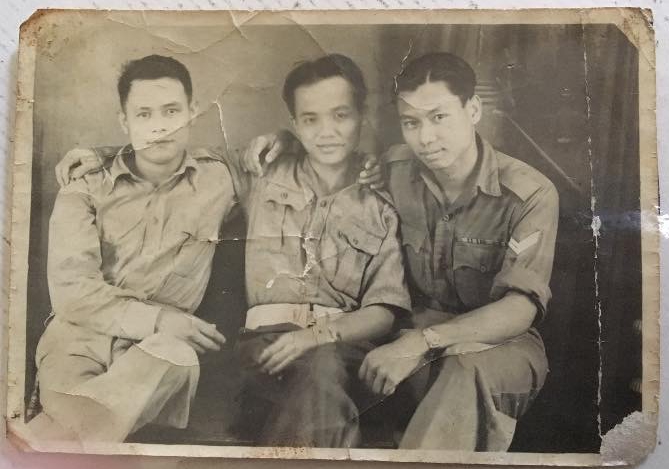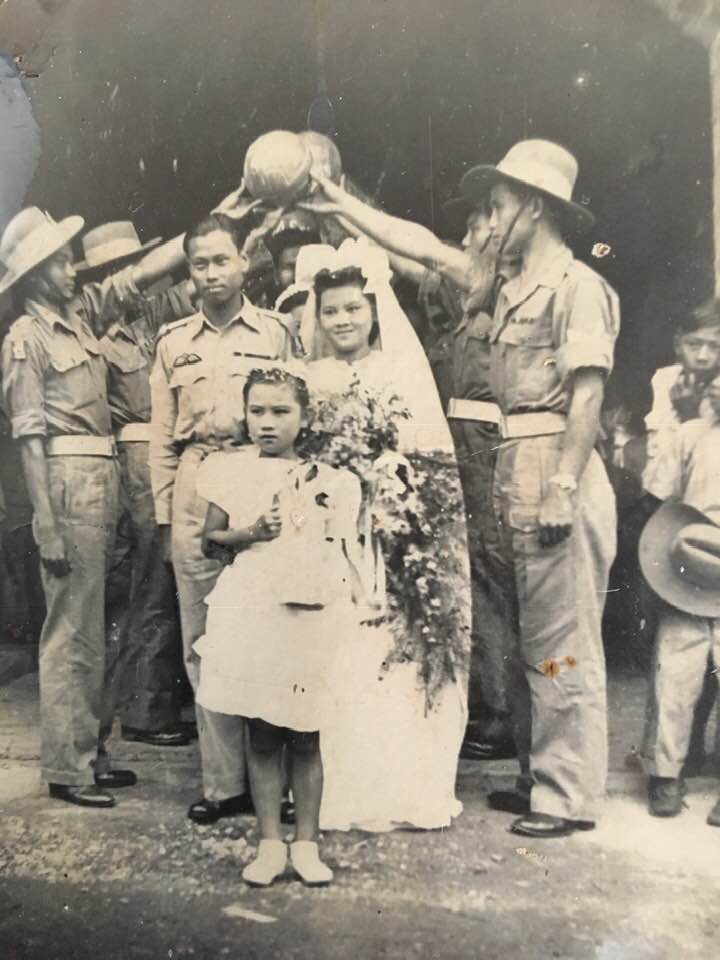Saw Mya Maung aka Michael Shwe
Burma Frontier Force; Burma Signals; Inter-Services Liaison Department
The story of Michael Shwe is especially fascinating as it spans the period of Burma’s military history which is the scope of this website. It begins with an underage Michael Shwe joining the Burma Frontier Force (B.F.F.) in 1941. He joined the retreat to India after which he was posted to the Burma Signals. At the end of the war, he was parachuted into Burma on an intelligence gathering mission for the Inter-Services Liaison Department (I.S.L.D.). When peace came, he became part of the new Burma Army being organised by the British in anticipation of Burmese independence. Following independence, Michael Shwe, himself a Karen, joined the Karen rebels and was wounded at Insein in 1949. I am grateful to the family of Michael Shwe for sharing his story and photographs.
Saw Mya Maung, known as Michael Shwe, was born on 17th November 1926. He was a Karen, many of whom served the British with great loyalty before and during World War 2. On 15th September 1941, at the age of 15, he enrolled with the Burma Frontier Force (B.F.F.) and was given the service number 9241. The B.F.F. was a civil force which came directly under the Defence Department of Government of Burma and before the war was operated quite separately from the Burma Army. The role of the B.F.F. was to protect the frontier of Burma and to provide internal security on the frontier areas. Given that he was a minor, Michael Shwe had to falsify his date of birth in order to enrol, no doubt with the assistance of his recruiter, and gave his birth date as 24th March 1924. He joined the B.F.F. Signals Unit, a specialist unit which came under the Reserve Battalion, B.F.F. with headquarters and depot at Pyawbwe, near the modern capital of Naypyidaw.
The B.F.F. Signals Unit provided wireless communications between certain B.F.F. battalion headquarters and their outposts, and between Headquarters, B.F.F. and the battalions. The unit also provided wireless detachments to support civil touring officers and their escorts. From the outbreak of war in the west in 1939 until the Japanese invasion of Burma in 1942, the B.F.F. Signals Unit was confronted with an ever increasing demand for wireless sets and trained personnel. No doubt it was exactly this pressure which encouraged the recruitment of underage soldiers for the signals role. After signing up, Michael Shwe underwent nine months infantry and wireless operator training at Pyawbwe. His commanding officer was Captain (later Major) Henry Vincent Hayfield, Royal Signals. The training was interrupted by the Japanese bombing of Rangoon in December 1941 and Michael Shwe moved to Anisakan (Anesakhan), near Maymyo (Pyin Oo Lwin), to complete his wireless training. After a time here, he passed his wireless operator course. At this time, Maymyo was also the location for the civil Government and for Burma Army Headquarters.
With the Japanese drawing ever closer, the decision to evacuate Maymyo was taken and was complete by 25th April 1942.[1] Michael Shwe and his unit left by train for Myitkyina where they stayed a few days until they were ordered to leave for India (the final evacuation of Myitkyina was ordered on 7th May 1942). The B.F.F. Signals Unit left on foot with many other army units, stragglers and civilians. The intended route was to head north from Myitkyina and to reach India via the Hukawng Valley. After several days Milestone 105 was reached (on what is presumed to be the Myitkyina-Sumprabum road). Michael Shwe later wrote, “The monsoon had already started. The route to India was mountainous, slippery and rough.”
For an unexplained reason, Major Hayfield now granted several soldiers, including Michael Shwe, indefinite leave with three months’ pay. In Michael Shwe’s group there a dozen other soldiers, mainly signalmen. The group was provided with a wireless set with which they could “contact headquarters” but whether they were intended to act as a guerrilla unit or not is not known. A few days after leaving the main unit, the men encountered Brigadier Francis William Haswell. Haswell had until recently been the Commanding Officer of the 9th (Reserve) Battalion, The Burma Rifles but by early April 1942 he had been ordered to raise the Chin Levies, having been Commandant of the Chin Hills Battalion, B.F.F. for a time before the war. When Michael Shwe’s group ran into Haswell he was alone driving a Jeep, accompanied only by his dog. He told the leader of the group that the Japanese were now in Myitkyina and asked the men to come along with him to Sumprabum. The B.F.F. signalmen went along with Haswell to Sumprabum where they stayed for a few days before moving on to Fort Hertz (Putao). During the journey to Fort Hertz, Michael Shwe suffered a severe attack of malaria. This was his first attack and he would later come close to death from a bout of cerebral malaria when on an intelligence operation in the Karen Hills in 1945. Obviously, he recovered from this first bout, having been well cared for by two comrades, Naik Samlut La and Signalman Maung Tsin, and the group arrived safely at Fort Hertz. Sometime after, the men were summoned by Haswell to the airstrip where they were ordered to leave their rifles, ammunition and equipment behind and to board a Dakota aircraft. Not knowing where they were bound, the men boarded the plane somewhat apprehensively. The plane took off shortly afterwards and there followed an uneventful flight to Tinsukia in Assam, India.
Michael Shwe and his comrades received a warm welcome as they left the plane at Tinsukia. They were greeted by ladies of the Women’s Volunteer Group and treated to hot tea and food. Michael Shwe was soon on the move again and eventually reunited with his unit at Dibrugah. By the end of 1942, he reached the new home of the Burma Army at Hoshiarpur in the Punjab. He was then granted one month’s war leave and spent some of that time in Amritsar. By the time of his return, the B.F.F. Signals Unit had been combined with signallers of the Burma Army to form a new Burma Signals unit. Michael Shwe then underwent intensive training with a number of his old comrades from pre-war days. By May 1943, a number of wireless detachments had been formed by the Burma Signals unit and sent to work with the Indian Army. It seems that Michael Shwe was included in one such detachment, a Signals Light W/T Detachment, which was sent to Imphal under the command of Captain R.E. Kitson, Royal Signals. Late in 1943, Michael Shwe was posted to the Northern Kachin Levies and came under the command of Major Douglas William D’Silva. With the Levies, he participated in the campaign to capture Myitkyina, travelling southwards over the route he had taken to escape the Japanese in 1942. Myitkyina was taken by American and Chinese troops in August 1944, with the support of the Kachin Levies and the 4th Battalion, The Burma Regiment.

Michael Shwe (R), wearing corporal's stripes which possibly dates the photo to 1944 or 1945, before he qualified as a parachutist.
After Myitkyina, Michael Shwe was recalled to the Burma Signals unit headquarters at Shillong in October 1944. He was sent on a parachute course at Jorhat in preparation for a future secret mission behind enemy lines. At some time during this period, Michael Shwe was recruited by the Inter-Services Liaison Department (I.S.L.D.), the cover name for the British Secret Intelligence Service (M.I.6) operating in India. Unlike the Special Operations Executive Force 136, the I.S.L.D.’s role was one of purely intelligence gathering. After completing his training, in August 1945, Michael Shwe was parachuted into the Karen Hills near Papun as part of an intelligence gathering operation, code-named ‘Blast IV’. The objective of the operation was to monitor and report back on Japanese troop movements southwards to Tavoy. However, the operation came to a swift end following the Japanese surrender on 15th August 1945. In a strange twist of fate, Michael Shwe then found himself helping Japanese soldiers who had not heard of the surrender. He then reported back to Headquarters, I.S.L.D. in Rangoon. It was around this time that he suffered a life endangering attack of cerebral malaria, enduring three months of hell which included attempts by a Buddhist monk to drive out the “hell-devil” inside him by beating him with a medicine stick.

Michael Shwe and bride with guard of honour, 1945 or later. Note that Michael is wearing a parachutists badge.
After four years away from home, Michael Shwe was reunited with his family, mostly likely then living in the Kyonpyaw area to the north east of Rangoon in the Irrawaddy Delta. After a period of leave, at Christmas 1945 he rejoined the Burma Signals who were by then stationed at Maymyo. He remained with the unit throughout the immediate post war period during which the British rebuilt and reorganised the Burma Army. On 4th January 1948, Burma became an independent country and units of the Burma Army transferred to the control of the new government. Michael Shwe was shortly afterwards commissioned as 2nd Lieutenant, service number B.C.5159. For his service with the British Army during the war against Japan, he was awarded the 1939-1945 Star and the Burma Star.
Peace in Burma was however short lived and a number of rebellions and insurgencies occurred in the aftermath of independence. In early 1949, the Karens rebelled against the new government, having suffered a number of atrocities at the hands of Burman militias and seeking their own separate state. Like many Karen soldiers, Michael Shwe was caught up in the fighting that followed. He had always been a keen sportsman and footballer and was playing football for the Army team in Rangoon in late 1948/January 1949 when the Karen revolt began. He found himself with the Karen defenders besieged at Insein, just to the north of Rangoon, and experienced some hard fighting. During the siege, he was badly wounded by a rifle bullet in the chest, “probably fired by a friendly Kachin or Chin soldier”. As a result of this wound, he had a lung removed. The Karen defenders at Insein fought on until May 1949 when they finally accepted defeat and, after a deal with the Government forces, crossed the Hlaing River to escape into the delta. The siege had lasted 112 days.
12 December 2019
